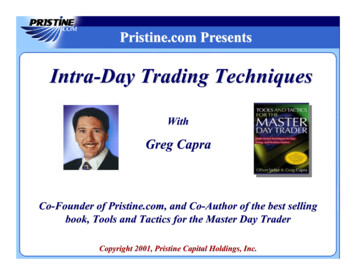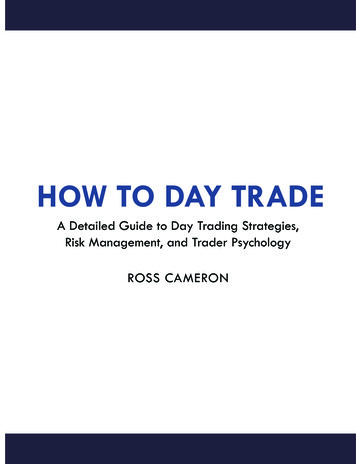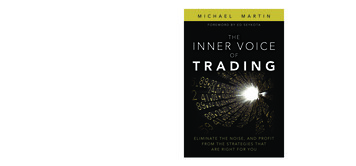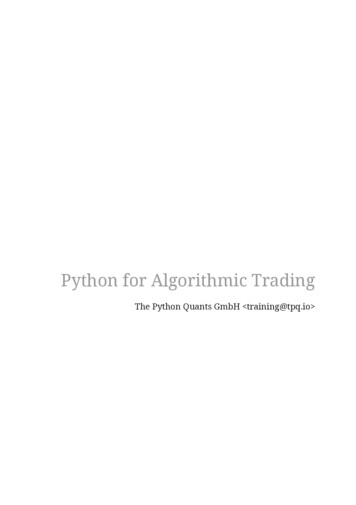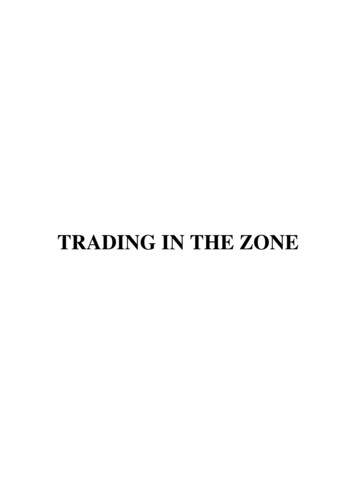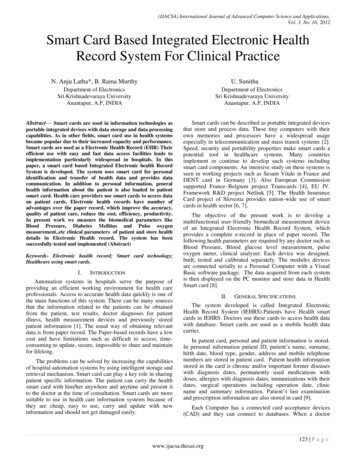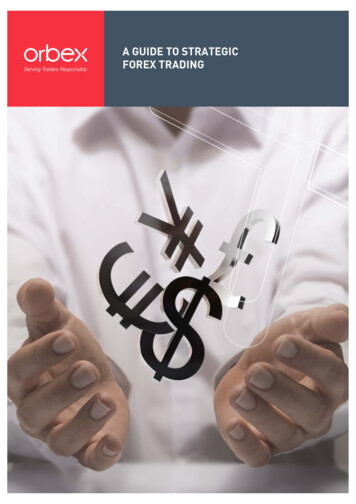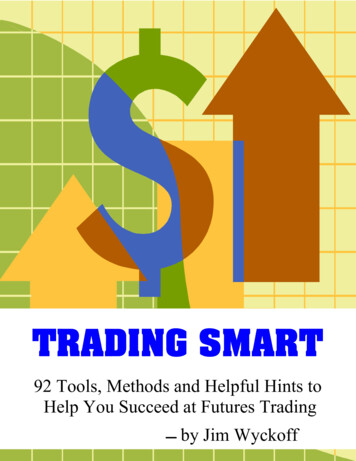
Transcription
TRADING SMART92 Tools, Methods and Helpful Hints toHelp You Succeed at Futures Trading1 by Jim Wyckoff
This publication is protected by International Copyright 2003. All rightsreserved. Reproduction in any form, electronic or mechanical, in whole or inpart, is strictly prohibited without written permission from Jim Wyckoff.Hello, my name is Jim Wyckoff. I am the proprietor of the analytical, educational and tradingadvisory service, "Jim Wyckoff on the Markets." I am also the chief technical analyst forFutureSource.com and for the OsterDowJones newswire. I was also the head equities analyst atCapitalistEdge.com. For nearly 20 years I have been immersed in markets and trading. Indeed,markets, trading and educating traders are my passion.In this information-packed book, I will share with you—in plain English—the tradingphilosophies and methodologies that have allowed me to survive and succeed in a fascinating butvery challenging field of endeavor: Trading futures. I will also touch upon other importanttopics about which traders need to know in order to survive and succeed in futures trading.I think you will enjoy the format of this book: short chapters that are easily comprehended. Toomany times in this industry, books on trading have been so technical and complicated that tradersfind themselves swimming in a sea of market statistics, computer code or mathematicalformulas. You will find none of that in this book. What you will find are important lessons andanecdotes that will move you up the ladder of trading success. You will also discover valuabletrading tools that you can incorporate into your own trading plan of action.Following are two of my most important trading tenets:¾ Like success at any other job, successful futures trading requires hard work. There are noshort-cuts. This is not a “qet-rich-quick” business.¾ Simple trading strategies work the best. I have read the classic technical analysis booksand talked face to face with the best trading professionals in the world. Most agree that,as my friend Stewart Taylor says, “Simple is Simply Better” when it comes to employingsuccessful trading strategies. All the neural networks and powerful computers in theworld won’t compare to a good, basic and well-researched trading plan. Don’t confusesimple strategies with easy trading. Simple trading methodologies still require a lot ofpreparation and work.Jim Wyckoff’s BackgroundI am into my third decade of involvement with the stock, financial and commodity futuresmarkets. I was a financial journalist with FWN (now called OsterDowJones) for many years,including stints as a reporter on the rough-and-tumble commodity futures trading floors in2
Chicago, New York and abroad. I covered every futures market traded in the U.S. — and somethat traded overseas — at one time or another.I was born and raised in Iowa, where I now reside. I have a wonderful wife and two greatchildren. I work very hard on the job, but also play hard after work, as I love adventures. Fromdriving a Jeep across the highest mountain pass in the continental U.S., to extreme wintercamping in the Boundary Waters, to hiking in the jungles of South America, I’m always up for anew challenge.I know you will enjoy my book.Jim Wyckoff (jim@jimwyckoff.com)Tele: 1-319-277-8643Website: www.jimwyckoff.com3
Table of Contents1. Before You Make a Trade: 10 Critical Questions82. Volume and Open Interest: How to Use it to Trade More Effectively113. How to Handle a Losing Streak (Everyone has Them)134. Contrary Opinion: Making it Work for You155. What Are The "Big Boys" Up To? How use the Commitment of TradersReport in your Trading176. Support and Resistance – All-Important Levels on the Charts You MUSTIdentify!197. Understanding Those Big, Bad Commodity Funds218. “Collapse in Volatility” Portends a Bigger Price Move239. Using the “ADM” Method to Deal with Losing Trades2510. “Pyramiding” – When and When Not to Do it2711. “Follow-Through” – its Significance for Your Market Position2812. "Cash Basis" -- How it Works3013. An Introduction to an Exciting Market — FOREX3214. “ OK, Maybe I Should Just Do the Opposite”3415. Making the Momentum Indicator Work for You3616. Using Joe Granville’s “On Balance Volume” (OBV) to Your TradingAdvantage3817. Eight Short-term Technical Tools that can Make You Money3918. Technical Traders – Don’t Ignore the Fundamentals – PLEASE!4219. Selling Options: The Real Story4420. Why, When, and How to Buy Options on Futures4621. A Realistic Look at Futures Trading4822. When To Quit Your Day Job5023. Employing Protective Stops to Manage Your Trades5324. The “Andrews Pitchfork” Trend Lines Indicator: A Cool Secondary Tool5525. A Short Primer on Welles Wilder’s “True Range” and “Average True Range”5826. The K-Wave: A Cycle Worth Examining604
27. Don't Hold Your Breath Too Long While Under Water6228. Entry and Exit Strategies for Maximum Profitability6429. Jim Wyckoff: One of my Favorite "Trading Setups"6630. Fear and Greed: Two Strong Emotions to Manage in a Grain WeatherMarket6831. Those Fascinating Fibonacci Numbers and the Golden Ratio7032. Identifying Overbought and Oversold Markets using The Keltner Channel7233. Identifying Market "Noise"7434. Futures Trading: The Ultimate "Head Game"7635. 11 Fascinating Market Correlations You'll Want to Use7836. 13 Different Market Orders and When to Use Each8037. The Single Most Important Aspect of Futures Trading8338. "Why Economists don't Make Good Traders" and a Few Nuggets8539. The Basic Principles of "Swing Trading"8740. "System Trading:" What Is It? Should you Buy and Use a Trading System?8941. Understanding and Using Donald Lambert's "Commodity Channel Index"9142. The MACD Indicator: A Great Secondary Tool9343. 4 Key Questions to Gauge Your Trading Success9544. Never Stop Learning! Education's Role in Your Long-Term Trading Success9745. The Top 10 Mistakes Traders Make9946. Fear Factor: The Impact of Trading With "Scared Money"10147. Nuggets You can use from a Trading Seminar10348. Don't Fight the Tape!10549. Using Larry Williams' Percent Range Indicator in Your Trading10750. Formulating Your Own Plan of Action10951. Quotes, Nuggets and Useful Tidbits from A Trading Seminar11152. The Elliott Wave Theory Demystified11453. How I use Bollinger Bands in My Trading11754. Another Secondary Tool: The DMI11955. EMAs: Where They Belong in Your Trading Toolbox12156. Howe's Limit Rule: Making it Work for You12357. Simple Moving Averages: A Helpful, but Secondary Tool12658. The Importance of Basic Trading Tools Like the Venerable Trend Line1285
59. The Importance of Psychology in Trading13060. A Look at Seasonality in 10 Markets13361. How to Choose a Futures Broker that Fits Your Style13662. Spread Trading: More Complicated, Yes. But Less Risk, and Less Expense13863. Market Fundamentals: Use them to Avoid that "Naked Feeling"14064. Triple Moving Averages Explained14365. The Importance of "Knowing What You Don’t Know"14566. Using Two Popular Oscillators: Slow Stochastics and Relative Strength14767. This Trading "Checklist" Will Help You Execute with Confidence15068. Studying and Preparation: Don't Sell it Short!15269. Technical Traders: You Should Still Examine Fundamentals15470. Veteran Traders Share Their Secrets and Strategies15671. Trading Lingo: Definitions for the Less-Experienced Trader15872. Better to Be Profitable Than Right!16173. Keep Market "Noise" in Perspective — Set Bigger Price Benchmarks16374. Abell, Koppel Discuss Their Profitable Short-term Trading Strategies16575. RSI Indicator: The "Cornerstone" of Andrew Cardwell’s Trading Model16776. Jesse Livermore, World's Greatest Trader16977. Another 20th Century Great: Richard Wyckoff and His Methods17278. Trader Linda Bradford Raschke Gets "Back To Basics"17479. Tom Bierovic: Thoughts on Trading, and a Successful Trading Method17780. "Vibrating Prices" and the Trading Philosophies of W.D. Gann17981. Stan Erlich and Mark Cook on "Trading to Win"18282. John Murphy's Key to Success: Simplicity!18683. Hank Pruden on "Behavioral Finance" and Technical Analysis18784. Futures Trader Joe DiNapoli: Faring Well in a Tough Business18985. Chase Manhatten Technical Analyst Tirone: "You Need Game Plan"19286. Kaufman: Multiple Trading Methods and Market "Noise"19487. How Richard Lees Combines Physics Into His Technical Analysis19688. Trader Linda Raschke: Tips On Day-Trading the S&P 50019889. Mark Cook: "How to Lose Money Profitably"20190. Trader Mark Cook Reveals His Rules For Day-trading2036
91. Stan Ehrlich: Using Simple Cycle Analysis for Profit20592. 10 Key Questions on Measuring your Trading Progress and Success2077
Before You Make a Trade:10 Critical QuestionsA "Trading Checklist" of prioritized criteria not only will help you decide when to execute atrade, but will also help you identify potential winning trades.What kind of stuff should a trader put on a Trading Checklist? That depends on the individualtrader. Each trader should have his or her own set of criteria, or rules, that helps determine amarket to trade and the direction to trade it--including when to get in and out.Below are my Top 10 rules on my trading checklist.1. Are shorter-term and longer-term charts in agreement on price trend?I've told readers for years that this is my No. 1 trading rule. If the weekly, monthly and daily(and sometimes intra-day) bar charts are not in agreement on price trend, I'll likely pass on atrade. I'm usually a trend trader, and the "trend must be my friend" before I make a trade.2. Is this potential trade within my financial risk tolerance?To be a successful trader, I not only have to have winning trades, but I must survive the morenumerous losing trades I am likely to encounter. If I see a potentially profitable trading "set-up,"but the market is too volatile, I'll likely pass on the trade because of the potential for a bigdrawdown or even a margin call from my broker. An example is the energy markets a coupleyears ago. They were highly volatile. Certainly, there were some big moves (and tradingopportunities for some) in the energies--both up and down. However, when a 75-cent, or more,daily move in crude oil is a "routine" trading session, that market is too volatile for my risktolerance--at least when trading straight futures.3. What is the potential risk-reward ratio of the trade?My risk-reward ratio in a futures trade should be at least three to one on maximum profitpotential. In other words, if my risk of loss is 1,000, my maximum profit potential should be atleast 3,000. Anything less is not worth making the trade. Now, any eventual profit that is mademay not always attain that three-to-one risk-reward ratio, but the point here is there should be the"potential" for a profit three times greater than your capital at risk in the trade.4. Has there been a price "breakout" from a trading range?One of my favorite trading "set-ups" is when prices have been in a trading range--between keysupport and resistance levels--for an extended period of time (the longer, the better). This type8
of trading range is also called a congestion zone, or a basing area when at historically lower pricelevels. If the price breaks out of a range (above the key resistance or below the key support), Ilike to enter the market--long on an upside breakout or short on a downside breakout. A safermethod would be to make sure there is follow-through strength or weakness the next tradingsession--in order to avoid a false breakout. The trade-off there is that I could be missing out onsome of the price move by waiting an extra trading session.5. Is there a potentially good entry point if the trade looks good?Entry points in trades most times should be based on some type of support or resistance levels ina market. If I see a potential set-up for a long-side trade, I will wait for the market to push upthrough a resistance level and begin a fledgling uptrend. Then, if I do go long, I'll set my sellstop just below a support level that's not too far below the market. And if the trend does notdevelop and the market turns back south, I'm stopped out for a loss that's not too painful. Anotherway to enter a market that is trending (preferably just beginning to trend) is to wait for a minorpullback in an uptrend or an upside correction in a downtrend. Markets don't go straight up orstraight down, and there are minor corrections in a trend that offer good entry points. The key isto try to determine if it is indeed just a correction and not the end of the trend.6. Is there a support or resistance level nearby, at which I can set a protective stop when Ienter the trade?This is my exit strategy, and is one of the most important factors in trading futures. On when toget out of a market, I have a simple, yet very effective method: Upon entering a trade, if I place asell stop below the market if I'm long (buy stop if I'm short), I know right away approximatelyhow much money I could lose in any given trade. I will never trade straight futures withoutemploying stops. Neither should you. Thus, I will never be in a trade and have a losing positionand not know where my exit point is going to be.7. Do "fundamental" market factors raise any warning flags?Those who have read my features know I base the majority of my trading decisions on technicalindicators and chart analysis--and also on market psychology. However, I do not ignorefundamentals that could impact the markets I'm trading. Neither should you. There are U.S.government economic reports that sometimes have a significant impact on markets. Associationsalso release reports that impact futures markets. Even private analysts' estimates can movemarkets. I make it a priority to know, in advance, the release of any scheduled reports orforecasts that have the potential to move the market for which I'm thinking about trading. I don'tlike surprises when I am in the middle of a trade.8. What do computer-generated indicators show? (RSI, DMI, Stochastics,
How to Choose a Futures Broker that Fits Your Style 136 62. Spread Trading: More Complicated, Yes. But Less Risk, . 71. Trading Lingo: Definitions for the Less-Experienced Trader 158 72. Better to Be Profitable Than Right! 161 73. Keep Market "Noise" in Perspective — Set Bigger Price Benchmarks 163 74. Abell, Koppel Discuss Their Profitable Short-term Trading Strategies 165 75. RSI .


